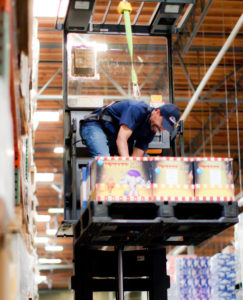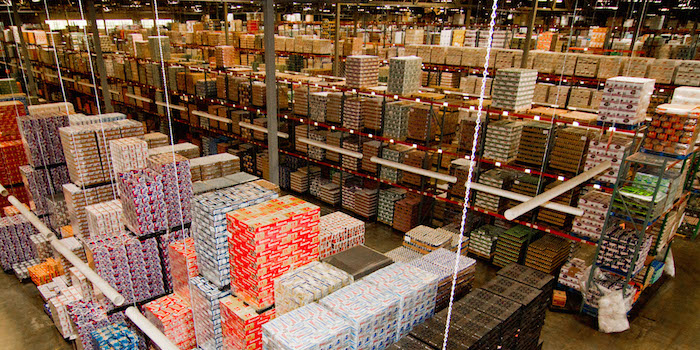Created out of a series of mergers and acquisitions among family-run businesses in the Pacific Northwest, Columbia Distributing is one of the largest beer distributors in the U.S., at more than 35 million cases per year. The company, run since 2012 by a family-run, long-term holding company called Meritage based in New York City, covers the majority of Washington, Oregon and northern California. MillerCoors is its major domestic supplier.
 Last year, Columbia announced its succession plan, with President Chris Steffanci in line to take over as CEO effective Jan. 2, 2018. Steffanci has a long career in the beer business, both on the supplier and wholesaler side of the industry. He spent time at E&J Gallo, Diageo, Heineken and Pabst before settling in at Columbia about vie years ago.
Last year, Columbia announced its succession plan, with President Chris Steffanci in line to take over as CEO effective Jan. 2, 2018. Steffanci has a long career in the beer business, both on the supplier and wholesaler side of the industry. He spent time at E&J Gallo, Diageo, Heineken and Pabst before settling in at Columbia about vie years ago.
“Spending time on the supplier and distributor side gives you a unique perspective,” Steffanci says. “It’s beneficial to understand the entire supply chain, and that’s a big part of our talent development. We spend a lot of time making sure employees have the opportunity to move through our organization of 3,200 people, and that we foster talent from within the industry.”
While many beer distributors are slow to embrace change, Columbia sees evolution as an essential part of surviving in a competitive industry.
“Sometimes people outside the second tier think of beer distributors as old school and antiquated,” Steffanci says. “That can sometimes be the case, but we have a clear strategy about how we can move forward. We focus on four key pillars: growth in business development, route to market, corporate branding and (most importantly) company culture.”
Beer Growth Trends
Craft beer’s exponential growth over the past decade has begun to slow, but there are still pockets within the industry that are trending up.
 “Craft is growing but slowing,” Steffanci says. “But we’re seeing that local and quality still matter to consumers. Brand relevancy still matters. We find that the largest growth in craft is coming from small, local breweries.”
“Craft is growing but slowing,” Steffanci says. “But we’re seeing that local and quality still matter to consumers. Brand relevancy still matters. We find that the largest growth in craft is coming from small, local breweries.”
Mexican imports – particularly on the premium end – continue to grow as well, he adds. And a plus for Columbia Distributing is the growth of the functional beverage market.
“We consider ourselves a beverage distributor, not just a beer distributor,” Steffanci says. “About thirty percent of our business is non-alcohol, and we’re seeing ‘better-for-you’ beverages growing dramatically.”
The challenge for Columbia, like the beer distribution market in general, is the non-craft domestic portfolio. Large, regional craft brewers have leveled off, and big domestic brands are struggling. The economy and sub-premium part of the company’s portfolio is particularly challenging, so while Columbia is seeing gains at the top of the pricing spectrum, there aren’t corresponding gains at the bottom.
Working with Suppliers
Steffanci’s experience working on the supplier side has helped give Columbia insight as it partners with brewers across the country. One major focus for the company is chain stores, which account for 45% of Columbia’s volume.
 “We have a chain team of 42 people who call on accounts, in addition to a full shelf reset team, category management team and analysts,” he says. “I believe we have the largest distributor chain organization in the country, and certainly we have a bigger team than a lot of the suppliers we work with. That’s critical to our success, especially as the retail tier consolidates and becomes more important to wholesalers.”
“We have a chain team of 42 people who call on accounts, in addition to a full shelf reset team, category management team and analysts,” he says. “I believe we have the largest distributor chain organization in the country, and certainly we have a bigger team than a lot of the suppliers we work with. That’s critical to our success, especially as the retail tier consolidates and becomes more important to wholesalers.”
Steffanci is also focused on growing Columbia’s core business, which falls under top line growth in its four pillars of success.
“We always want to focus on the suppliers who helped us build our business,” he says. “You can never forget about the part of the business that drives so much volume, and meets the needs of many consumers in many channels.”
And he’ll continue to find acquisition targets – both distributors and new brands for the portfolio – as Columbia continues to grow.
“We like to play in a lot of diversified categories,” Steffanci says. “For both the beer and non-alcohol categories, we want to be the number one or two player in every market, and represent the number one or two brand in every category.”










do you have any non alcholic beer